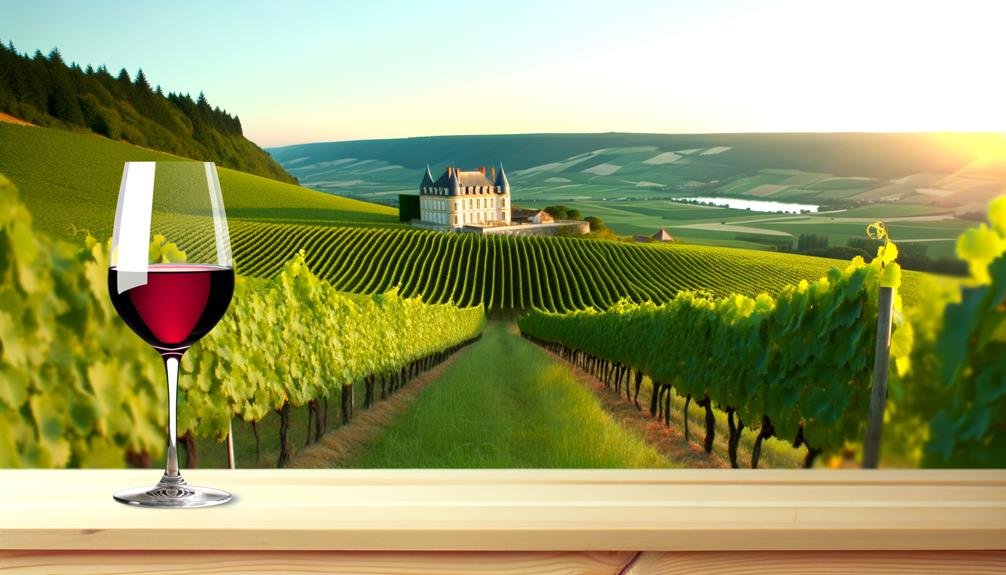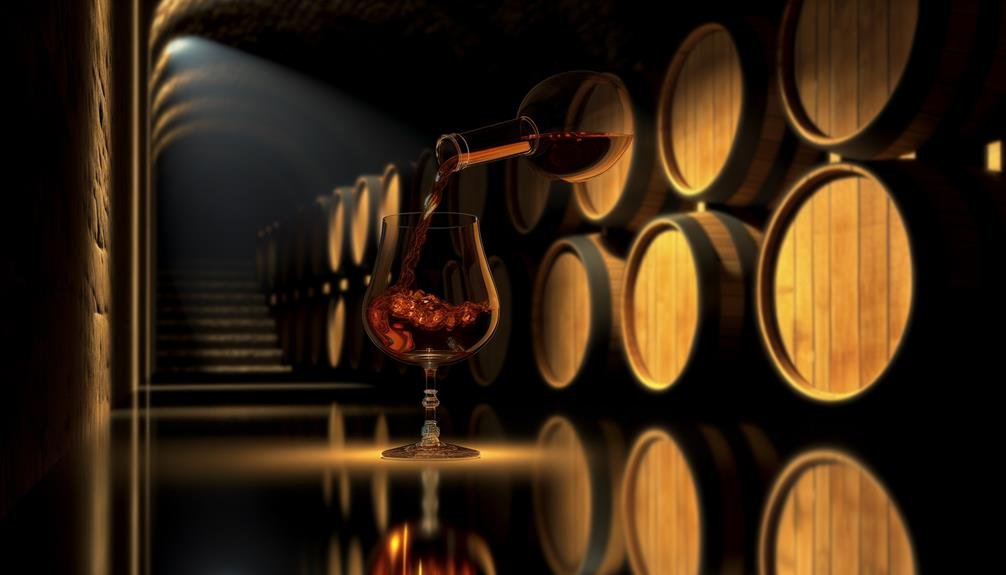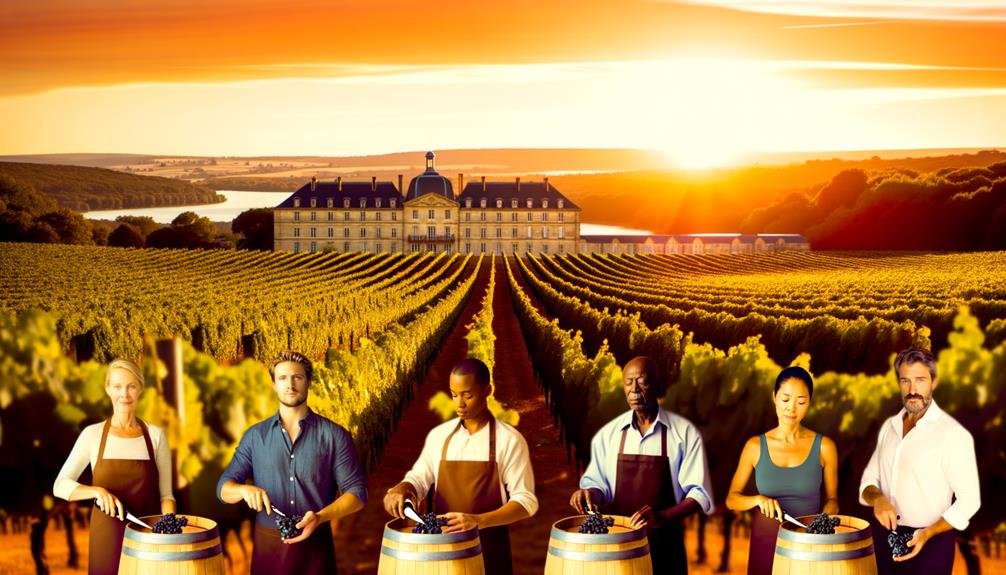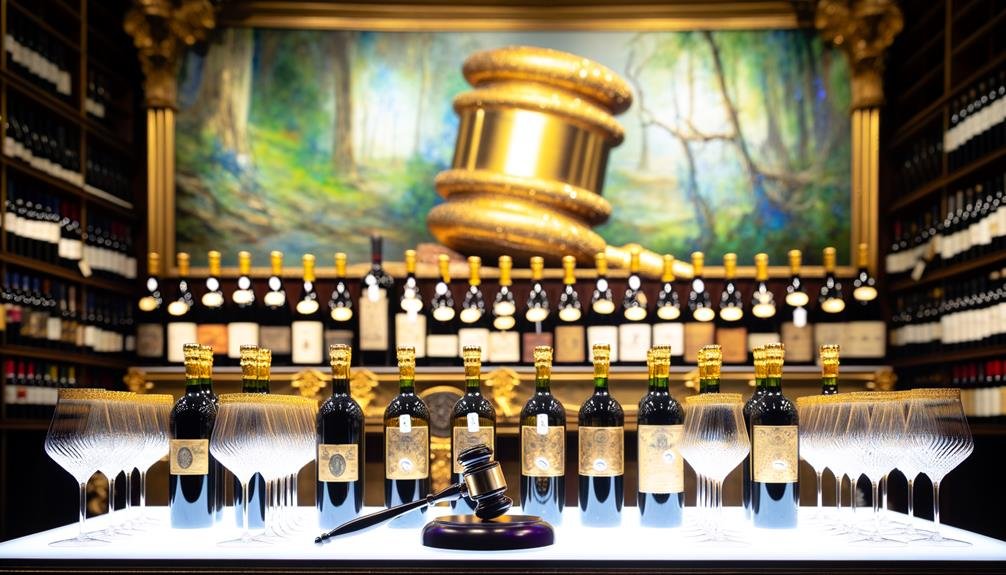When delving into the realm of luxury wine, we uncover a rich tapestry woven with elements of history, geography, and craftsmanship. These exceptional wines hail from renowned regions like Burgundy and Bordeaux, standing not just as drinks but as symbols of cultural and agricultural excellence.
What distinguishes them? Let's examine the impact of oak aging, the meticulous care in vineyard cultivation, and the extended aging process. Each of these factors plays a crucial role in shaping the intricate flavors and longevity that define these remarkable wines.
As we unravel the distinctive traits of luxury wines, it prompts us to reflect on how these elements contribute to their prestigious reputation.
Classic Wine Regions

Classic wine regions like Burgundy, Bordeaux, Champagne, and the Mosel Valley are highly esteemed for their rich history and exceptional terroir. These regions have a long-standing reputation for producing top-tier wines that showcase unparalleled quality, a result of centuries of expertise in winemaking and perfect growing conditions.
Burgundy is renowned for its exquisite Pinot Noirs and Chardonnays, while Bordeaux is famous for its bold blends of Cabernet Sauvignon and Merlot. Champagne stands out for its elegant sparkling wines that exude finesse and sophistication.
The Mosel Valley, known for its outstanding Rieslings, offers a distinctive profile characterized by a harmonious blend of minerality and sweetness. These regions not only shape global wine standards but also lead the way in innovation within the wine industry, ensuring their enduring influence and prestige.
Collectible Wine Types
When it comes to collectible wines, certain types stand out for their age-worthiness, rarity, and unique characteristics, making them highly coveted among wine enthusiasts and collectors. These wines not only offer exceptional taste but also the potential for increased value over time.
Bordeaux wines, with their prestigious Premier Cru Classé designations, are among the most sought after collectibles. Châteaux like Lafite and Margaux produce some of the most prized bottles in the region, known for their quality and aging potential.
In Burgundy, wines from Domaine de la Romanée-Conti are considered some of the most exclusive and expensive in the world. Their limited production and exceptional quality make them a top choice for collectors looking for truly exceptional wines.
Champagne, especially vintage offerings from renowned houses like Dom Pérignon, are highly valued for their ability to age gracefully and develop complex flavors over time. These bottles are often considered investments in addition to being enjoyed for special occasions.
For those seeking collectible Rieslings, the Mosel Valley in Germany is a treasure trove. Known for its wines that exemplify purity and longevity, Rieslings from this region, such as those from top producers like Egon Müller, are highly prized by collectors for their exceptional quality and aging potential.
Oak Aging Importance

Oak aging plays a crucial role in creating high-quality luxury wines by significantly influencing their flavor profile, complexity, and aging potential.
When wines are aged in new French oak barrels, particularly sourced from Quercus petraea, they acquire subtle notes of vanilla, spice, and toast, enhancing their sophistication. This process also facilitates controlled oxidation, improving the wine's texture, and integrating tannins for a smoother finish.
Despite the significant cost of around $800 per barrel, oak barrels are considered indispensable for producing wines that meet the elevated standards of luxury.
To stay ahead in the wine industry, innovators are constantly exploring various oak aging techniques to strike a balance between tradition and modernity and craft exceptional wines that stand out in the market.
Wine Aging Process
Aging red wines is a careful process that turns them from harsh and unpalatable when young into beautifully balanced and complex masterpieces with time. This metamorphosis depends on key elements to ensure the wine reaches its full potential.
Firstly, aging helps to mellow out rough tannins and bring acidity into perfect harmony, resulting in a smoother and more enjoyable wine.
Additionally, as the wine matures, it gains intricate flavors like dried fruits, nuts, and spices that are absent in younger wines.
Choosing high-quality oak barrels, particularly those made from French oak, plays a crucial role in the aging process. These barrels impart subtle flavors to the wine and allow for gradual oxygenation, which is vital for aging to occur effectively.
Creating the ideal storage conditions is also essential for proper aging. Cellars need to be cool, dark, and humid, which can be quite expensive to maintain but is necessary for the wine to develop gracefully over time.
Production Costs

Understanding how wine ages is essential in luxury wine production, shedding light on the significant costs involved. Each wine barrel, typically crafted from premium French oak, can be quite pricey at around $800 per barrel, adding approximately $2.70 to the cost of each bottle.
Older vines, though enhancing the wine's flavor profile, require years of careful cultivation before yielding top-quality grapes. Some wineries even age their wines for up to 15 years before releasing them to the market, further adding to the investment needed.
Despite concerns about the environment, oak aging remains a fundamental practice in producing high-end wines. The meticulous attention to detail in managing the vineyards, the use of top-notch materials, and the extended aging process all contribute to the higher production costs, which ultimately influence the final pricing of luxury wines.
Wine Market Trends
The luxury wine market is evolving with a focus on collectible wines and the influence of auction houses on wine values. This shift is driven by consumer preferences and market dynamics, showcasing a vibrant and dynamic industry.
One significant trend is the rising demand for rare vintages, with collectors and investors seeking out limited-edition and historically significant wines, leading to an increase in their market value. This trend highlights the appeal of unique and exclusive wines in the luxury market.
Another notable development is the integration of technology such as blockchain and AI to authenticate wines and forecast market trends. This advancement helps reduce the risk of counterfeit products and enhances transparency in the market, instilling trust among consumers and investors.
Moreover, the growing emphasis on sustainable practices is shaping the luxury wine market, as eco-conscious consumers advocate for environmentally friendly production methods. This shift towards sustainability is influencing the types of wines being offered in the market, reflecting a broader societal concern for environmental impact.
Furthermore, the expansion of the global wine market into emerging regions like Asia and South America is diversifying the industry landscape. These new markets are becoming significant players in the luxury wine sector, bringing unique flavors and profiles to the global market.
Record Wine Sales

Wine sales records often attract the attention of collectors and enthusiasts, highlighting the high value placed on rare and historically significant bottles. These sales showcase the premium status of certain wines, driven by factors like their origin, aging potential, and unique stories.
Iconic auctions held in cities such as London and Hong Kong witness intense bidding wars for wines from renowned regions like Burgundy, Bordeaux, and Napa Valley. For example, a bottle of 1992 Screaming Eagle Cabernet Sauvignon was recently sold for a staggering $500,000, setting a new standard in luxury wine transactions.
The market for high-end wines is truly remarkable, as demonstrated by some notable sales figures. One standout example is the sale of a bottle of Château Yquem from Bordeaux dating back to 1811, which fetched a remarkable $117,000 in an auction. Similarly, a bottle of Romanée-Conti from Burgundy, produced in 1945, was sold for an astonishing $558,000, showcasing the enduring appeal of rare vintages. These records not only underscore the cultural significance of fine wines but also highlight their substantial economic impact on the global market.
In addition to these prestigious sales, wine enthusiasts also appreciate the craftsmanship and quality of iconic wines like Cheval Blanc from Bordeaux, dating back to 1947. This particular bottle was acquired by a discerning private collector for $304,375, reflecting the enduring allure of well-aged vintages.
Furthermore, the auction market has also seen strong interest in wines from newer regions like Australia, with a bottle of Penfolds Grange from 1951 fetching $38,420 in a private collection sale. These diverse examples collectively illustrate the diverse appeal and value of premium wines in the ever-evolving wine market.
Conclusion
Luxury wines are like rare treasures in the world of viticulture, representing the highest level of winemaking with their ties to historic wine regions, expert craftsmanship, and exceptional aging potential.
What sets these wines apart even more is the delicate touch of oak aging and the meticulous care given to the vineyards where the grapes are grown.
As the wine industry progresses, the fascination with collecting vintage bottles and the impressive sales they garner underscore the enduring appeal of these top-tier wines.
This perfect balance of honoring traditions while embracing innovation ensures that luxury wines will always captivate the hearts of wine enthusiasts and collectors.